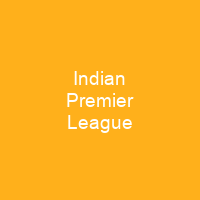Is the Indian Premier League (IPL) just another cricket league, or is it a phenomenon that reshapes the very fabric of Indian culture and economy? The Indian Premier League (IPL), founded in 2007, has grown from a fledgling idea into an unmissable spectacle. It’s not merely a game; it’s a cultural event that captures the essence of India’s vibrant spirit. The IPL is more than just cricket—it’s a celebration of diversity and unity under the sun.
Origins and Growth
The IPL officially commenced in April 2008 with eight teams, each representing different cities across India. From those humble beginnings, it has blossomed into a league that features ten state or city-based franchise teams. The journey hasn’t been without its challenges; financial struggles led to franchise closures and expansions. Yet, the resilience of the IPL is evident in how it continues to evolve, adding new franchises like Lucknow Super Giants and Gujarat Titans.
Financial Impact
The league’s brand value skyrocketed to ₹90,038 crore (US$11 billion) by 2022. This figure alone speaks volumes about the IPL’s economic significance. The financial impact is not just monetary; it also includes the creation of jobs and the promotion of tourism. The IPL has become a decacorn valued at $10.9 billion, marking a significant milestone in its journey.
Rules and Regulations
The IPL operates under unique rules that set it apart from other leagues. For instance, teams can use a substitute player named from five possible players, and the Decision Review System (DRS) allows two reviews per innings. These innovations ensure fairness and enhance viewer engagement.
Key Statistics
The 2022 season offered ₹46.5 crore in prize money, with the winning team netting ₹20 crore and the losing side receiving ₹13 crore. The salary cap for each squad in the 2024 season is set at ₹120 crore, ensuring a balance between star power and financial sustainability.
Player Contracts
Under-19 players must have played first-class or List A cricket to be picked, ensuring that only the best talent participates. Player contracts run one year but can be extended by one or two years. Overseas players’ salaries are paid in their chosen currency at the exchange rate on contract due date or payment date.
Team Composition
The league has a maximum of four overseas players allowed for each team, with three allowed for impact players. Teams must include 25 players, with a maximum of eight overseas players. From the 2024 season, bowlers will be allowed to deliver two bouncers an over, adding another layer of strategy and excitement.
Historical Achievements
The reigning champions are the Kolkata Knight Riders, who secured their third title by defeating the Sunrisers Hyderabad in the 2024 IPL final. Teams like Chennai Super Kings and Mumbai Indians have won five titles each, while others such as Rajasthan Royals, Deccan Chargers, Sunrisers Hyderabad, and Gujarat Titans have each won a single title.
Awards and Records
Brendon McCullum was the first player to wear the Orange Cap, while Shaun Marsh was the inaugural winner of the award. David Warner has won the award three times, more than any other player. Bhuvneshwar Kumar and Dwayne Bravo are the only players to have won the Purple Cap twice.
Challenges and Controversies
The IPL hasn’t been without its controversies. The 2013 IPL spot-fixing case saw Ajit Chandila, Ankeet Chavan, S. Sreesanth, and Gurunath Meiyappan arrested for betting on matches. The Lodha Committee banned Rajasthan Royals and Chennai Super Kings for two years after finding them guilty of fixing games.
The financial rights of foreign national boards have also been a contentious issue. The Australian Cricketers’ Association opposed the BCCI’s arrangement, leading to disputes with Cricket Australia over the allocation of foreign players’ salaries.
Conclusion
The Indian Premier League is more than just a cricket league; it’s a cultural phenomenon that has transformed the way we perceive and engage with sports. From its humble beginnings in 2008, to becoming a decacorn valued at $10.9 billion, the IPL continues to evolve, setting new standards for innovation and excellence.

You want to know more about Indian Premier League?
This page is based on the article Indian Premier League published in Wikipedia (retrieved on March 14, 2025) and was automatically summarized using artificial intelligence.







